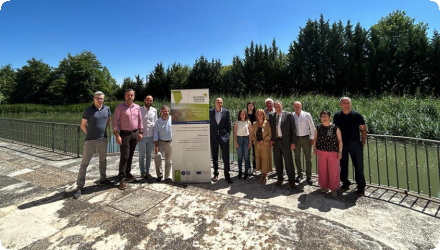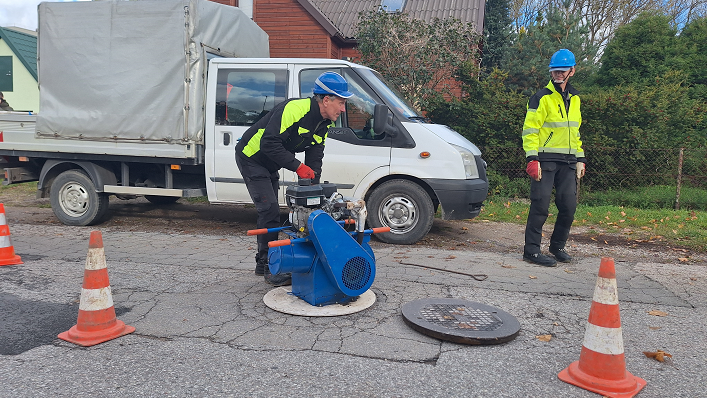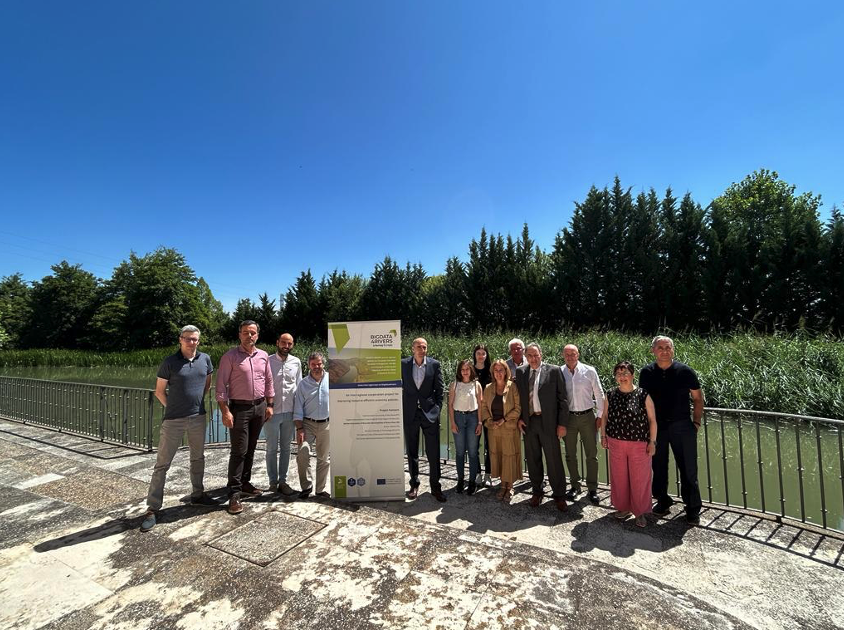Last update
2025
Summary
Kretinga is located 12 km east of the popular Baltic Sea resort town of Palanga, and about 25 km north of Lithuania's 3rd largest city and principal seaport, Klaipėda. The Stormwater Special Plan developed introduces a new approach towards more sustainable stormwater solution from an environmental perspective. This type of ecologically adapted stormwater investments have been implemented in Lithuania for the first time. If they function as well as predicted and can be disseminated through appropriate channels, there should be good possibilities to introduce similar investments in other Lithuanian towns.
Position
Latitude
55.8897
Longitude
21.24267
Project
NWRM
National Id
Lithuania_02
Installation date
2013
RBD code
LT2300
Transboundary
0
Photo gallery
Location of the project
In the southern part of Kretinga town, Lithuania, near the Akmena-Danė River, close to the main road Šiauliai–Palanga (Route A11).
NUTS Code
LT00 - Latvija
Project's objectives
1) reduction of formation and collection of stormwater;
2) reduction of the amounts of stormwater, centrally discharged into the environment;
3) reduction of pollution levels in stormwater;
4) ensure that stormwater is managed separately form domestic, industrial.
2) reduction of the amounts of stormwater, centrally discharged into the environment;
3) reduction of pollution levels in stormwater;
4) ensure that stormwater is managed separately form domestic, industrial.
Involved Partners
| Authority type | Authority name | Role | Comments |
|---|---|---|---|
Climate zone
cool temperate moist
Temperature
8.9 °C
Annual rainfall range
600 - 900 mm
Elevation range
27
Water bodies: Ecological Status
Moderate
Water bodies: Chemical Status
Unkown
Project scale
Micro
Project scale specification
This project is implemented at the city-district level within Kretinga town and focuses on the treatment of stormwater from a specific urban catchment (18 ha) using ecological infrastructure such as retention ponds and vegetated zones. It addresses localised water quality and urban runoff issues and does not extend to a regional or river basin scale.
Project area
18
Area subject to Land use change or Management/Practice change (ha)
18
Size
100
Size unit
m
Planned water retention time in the ponds is ~ 48 hours; under heavy rains, the time can be ~ 24 hours.
1) some planning constrains regardin local cultural ceritage, but problem solved; 2) there were some problems with planning paths for leasure zone near retention ponds, as there are building restrictions in such wastewater treatment areas, but the problem was successfully solved.
Costs investment
188000
Costs investment information
Cost effectiveness estimations have not been calculated. It would be interesting to compare e.g. construction and operation costs of wetland/retention pond (such stormwater treatment facilities are under construction in Kretinga town) with conventional oil-sludge separator, taking into account removal of pollutants per unit costs.
Evaluations will be carried out of the decrease of nutrients (P and N), hazardous substances, suspended solids and BOD from stormwater outlets after the construction of the treatment facilities.
Evaluations will be carried out of the decrease of nutrients (P and N), hazardous substances, suspended solids and BOD from stormwater outlets after the construction of the treatment facilities.
Financing authorities
Type of funding
EU-funds: Rural development funds
Comments
EU structural support according to the objectives provided in Cohesion Promotion
Operational Programme
Operational Programme
Comments
Municipal budget
Type of funding
Private funds
Comments
budget of municipal enterprises, providing services of stormwater management.
Compensations
0
Policy context
The measure was designed to address the problem of untreated urban stormwater runoff being discharged directly into the Akmena-Danė River, carrying high loads of pollutants such as sediments, nutrients, heavy metals, and pathogens. Rapid urban development in Kretinga had increased impermeable surfaces, leading to higher runoff volumes, reduced infiltration, and elevated risks of water pollution and ecological degradation in the river system. The project aimed to reduce these impacts through nature-based stormwater treatment solutions.
Land ownership
The land used for the stormwater treatment system in Kretinga is publicly owned, under the authority of the Municipality of Kretinga.
Community involvment
Yes
Design consultation activity
| Activity stage | Name | Key issues | Comments |
|---|
Policy target
| Target purpose |
|---|
|
Runoff control
|
|
Peak-flow reduction
|
|
Pollutants Removal
|
|
Oher Societal Benefits
|
Policy pressure
| Pressure directive | Relevant pressure |
|---|
Policy impact
| Impact directive | Relevant impact |
|---|
Requirement directive
| Requirement directive | Specification |
|---|
Contractual arrangements
1
| Arrangement type | Responsibility | Role | Name | Comments |
|---|---|---|---|---|
|
Contractual agreement
|
Supporting
|
Implementation
|
SWECO
|
Technical project
|
|
Contractual agreement
|
Supporting
|
Implementation
|
GreenWorks Indusrty
|
Construction
|
Part of wider plan
1
Wider plan type
| Wider plan type | Wider plan focus | Name | Comments |
|---|---|---|---|
|
Kretinga town special plan
|
Local scale plan, including all the town focuses
|
The system is subject to monitoring by Kretingos Vandenys and national environmental authorities to ensure compliance with pollutant reduction goals and regulatory standards.
The monitored parameters focus on water quality and pollution control, including suspended solids, total phosphorus, total nitrogen, and heavy metals such as cadmium, copper, lead, and zinc. Microbiological indicators like pathogenic bacteria (e.g., E. coli) are also monitored. During overflow or pollution incidents, additional parameters such as biological oxygen demand (BOD), chemical oxygen demand (COD), and ammonium nitrogen are assessed to evaluate environmental impact. These data help guide both routine maintenance and responses to extreme weather events or illegal discharges.
Maintenance
Regular maintenance is carried out by Kretingos Vandenys, including sediment removal, vegetation management, and inspection of stormwater infrastructure.
Edge of Field/Plot
Estimated reduction of contaminants in the designed and constructed facilities:
1) SS 80 percent.
2) Total phosphorus 50 percent.
3) Total nitrogen 30 percent.
4) Metals cadmium, copper, lead and zinc †“ 50 percent.
5)Pathogenic bacteria 70 percent.
1) SS 80 percent.
2) Total phosphorus 50 percent.
3) Total nitrogen 30 percent.
4) Metals cadmium, copper, lead and zinc †“ 50 percent.
5)Pathogenic bacteria 70 percent.
Improved public health and safety
Enhanced aesthetic and recreational value
Cost-effective pollution reduction
Increased local awareness and institutional capacity
Enhanced aesthetic and recreational value
Cost-effective pollution reduction
Increased local awareness and institutional capacity
Retained water
7776
Retained water unit
m3/day
Information on retained water
90 l/s in total (40 l/s in one and 50 l/s in another retention pond)
Information on increased water storage
The design mimics natural wetland processes, creating small aquatic zones and vegetated basins that act as temporary storage.
Water quality overall improvements
Positive impact-WQ improvement
Information on Water quality overall improvements
Due to natural sedimentation, filtration, and biological processes in the retention ponds and vegetated treatment areas.
Water quality Improvements (P) unit
% reduction pf pollutant
Water quality Improvements Nitrogen (N)
30
Wq Improvements n unit
% reduction pf pollutant
Water quality Improvements Total Suspended Solid (TSS)
80
Water quality Improvements (TSS) unit
% reduction pf pollutant
Water quality Improvements Copper (Cu)
50
Water quality Improvements (Cu) unit
% reduction pf pollutant
Water quality Improvements Zinc (Zn)
50
Water quality Improvements (Zn) unit
% reduction pf pollutant
Water quality Improvements Escherichia Coli (e.coli)
70
Water quality Improvements (e.coli) unit
% reduction pf pollutant
Water quality Improvements fecal coliforms (fecal coli)
70
1
The project created new vegetated and aquatic habitats in a previously sealed urban environmentHowever, no quantitative data on flora or fauna diversity, abundance, or ecological indices is available.
Information on Ecosystem impact climate regulation
The vegetated stormwater system contributes to urban cooling, carbon capture (vegetation), and increased evapotranspiration, but again, no quantified estimates are available.
These impacts are assumed as typical co-benefits of nature-based stormwater solutions, but not specifically measured here.
These impacts are assumed as typical co-benefits of nature-based stormwater solutions, but not specifically measured here.
Key lessons
1) reduction of formation and collection of stormwater, for example installation of impervious surfaces shall be avoided (except in potentially polluted territories), clean stormwater absorbing soil facilities should be installed, projected areas of potentially polluted territories shall be as small as possible, etc.,
2) reduction of the amounts of stormwater, centrally discharged into the environment, e. g. allow utilization of stormwater in the production process, watering of green areas, fire extinguishing, etc., and
3) reduction of pollution levels in stormwater, e.g. implement dry cleaning of potentially polluted territories, construct sheds in most hazardous areas.
4) Capacity must be resilient to extreme weather events. An overflow incident in 2023, due to intense rainfall, resulted in the discharge of untreated water. While no major environmental damage was reported, it highlighted the vulnerability of even ecological systems under climate-induced extreme events, and the need for emergency capacity and adaptive infrastructure.
2) reduction of the amounts of stormwater, centrally discharged into the environment, e. g. allow utilization of stormwater in the production process, watering of green areas, fire extinguishing, etc., and
3) reduction of pollution levels in stormwater, e.g. implement dry cleaning of potentially polluted territories, construct sheds in most hazardous areas.
4) Capacity must be resilient to extreme weather events. An overflow incident in 2023, due to intense rainfall, resulted in the discharge of untreated water. While no major environmental damage was reported, it highlighted the vulnerability of even ecological systems under climate-induced extreme events, and the need for emergency capacity and adaptive infrastructure.
Success factor(s)
| Success factor type | Success factor role | Comments | Order |
|---|---|---|---|
|
Attitude of decision makers
|
main factor
|
1
|
|
|
Financing possibilities
|
main factor
|
<p>EU funding was a big help.</p>
|
2
|
|
Available support tools
|
main factor
|
<p>During the MOMENT project, it was possible to gain knowledge about the similar retention ponds in Sweden. As this was one of the first (pilot) retention ponds in Lithuania, therefore, knowhow was very usefull.</p>
|
3
|
|
Legal obligations
|
main factor
|
4
|
Driver
| Driver type | Driver role | Comments | Order |
|---|---|---|---|
|
Legal obligations
|
Might be also other reasons, but the stormwater discharge in Kretinga town did not in some parameters comply with the pollution requirements before the construction of the two retention ponds
|
1
|
Transferability
This measure is highly transferable to other urban areas facing stormwater pollution, especially in small to mid-sized towns. Its success depends on strong local governance, public utility involvement, and integration with land use planning. Key aspects to watch include illegal drainage connections, maintenance capacity, and resilience to extreme rainfall, which can undermine system performance if not properly addressed.
English



